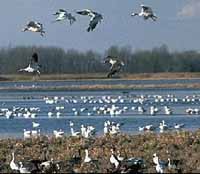Bird migration patterns shifting, an early warning of climate change
Like the canaries that once warned of danger in mine shafts, migrating birds are becoming harbingers of another risk - climate change.

Confused and disoriented by erratic weather, birds are changing migration habits and routes to adjust to warmer winters, disappearing feeding grounds and shrinking wetlands. Failure to adapt risks extinction, experts say.
This weekend, bird watchers and conservationists in dozens of countries staged events to mark World Migratory Bird Day with concerts, films and children's drawing contests to attract attention to the rising threat of global warming.
"Changes are already taking place in the habits of migrating birds," said Robert Hepworth, executive secretary of Convention on Migratory Species, a treaty under the auspices of the U.N. Environment Program.
Bird life already is under pressure from human intrusions like coastline development, but climate change is making matters worse.
"We are presiding over a managed retreat. The danger of climate change is that the retreat will become a rout," Hepworth said in an interview Saturday on the sidelines of an international climate change conference.
The Intergovernmental Panel on Climate Change, a body of some 2,500 scientists, has warned in a series of authoritative reports this year that high emissions of greenhouse gases - mainly from power plants, industries and vehicles - are likely to raise the Earth's average temperatures by at least 2 degrees Centigrade, or 3.6 degrees Fahrenheit, which is predicted to drive up to 30 percent of known animal species to extinction.
Migrating birds are especially vulnerable. Climate change can strike at each stage of their annual trek, from breeding ground to rest stops along their flyways, to the final destination.
Studies cited by the organization say arctic permafrost and tundra where many species breed is melting. Even moderate rises in sea levels can swamp wetlands where travelers stop to feed. Deserts are expanding, lengthening the distance between rests.
Birds face starvation when they arrive too early or too late to find their normal diet of insects, plankton or fish. With warmer winters in the north, some birds have stopped migrating altogether, leaving them at risk when the next cold winter strikes.
"Species that adapted to changes over millennia are now being asked to make those adaptations extremely quickly because of the swift rise in temperatures," Hepworth said.
"We don't know how many will survive. We will lose species," he said.
Hepworth recalls watching great V-formations of Bewick's swans in the skies of his native Britain, as they arrived from northern Russia for the summer. Now they are seen in declining numbers.
The extraordinary travels of the red knot is another example. The medium-sized shore bird breeds in Siberia and migrates to southern Africa, shedding half its body weight under the strain of flight that reaches the limits of survivability. The expansion of the north Africa deserts could push them over the edge.
The convention's scientific council says 84 percent of the 235 species listed in the treaty's annexes could be affected by changes in water availability, mismatched foods supplies, more frequent storms and competition with alien species intruding into their habitat.
The convention came into force in 1983 and is signed by 101 countries which have pledged to help preserve the habitat of wild animals.
Subscribe to Pravda.Ru Telegram channel, Facebook, RSS!




